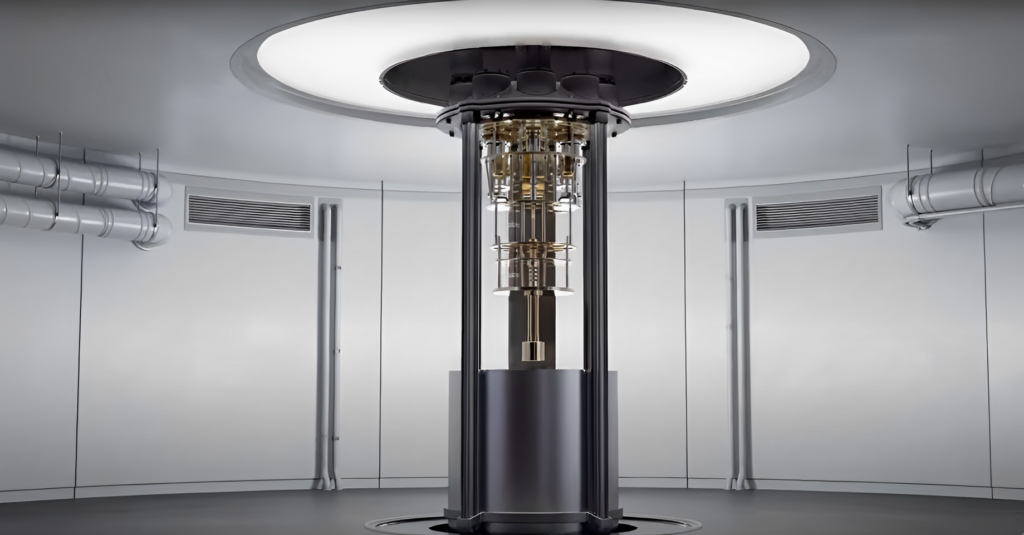
In the Hudson Valley, an hour’s train trip away from New York City, I am struggling to move a big, curved piece of metal. It is at the front of a large, cylindrical machine at least twice my size. IBM physicist Pat Gumann lends a helping hand and, together, we get it done. Closing the door of the world’s largest quantum computer fridge is no joke.
Quantum computing relies on keeping things cold. The quantum properties that make the computers work disappear at temperatures as cold as just a few degrees kelvin (around -271°C). The best fridges currently available can handle quantum computers with hundreds of quantum bits, or qubits – the basic quantum unit of memory. But to really start excelling over classical computers, quantum computers will need thousands of qubits. IBM wants to build one with 4000 qubits by 2025, which would be about 300 times more than its current biggest quantum computer. And for that, the team is going to need the massive fridge in front of me.
Gumann led the researchers who built it. It is fondly nicknamed Goldeneye after the James Bond film and its interior can reach 25 millikelvin, about 100,000 times colder than outer space. The fridge is a cylinder 2 metres in diameter and about 4 metres tall, but much of that is taken up with the tech to keep it cool. I suspect that I could just about fit in the compartment for quantum computers, but I don’t dare for fear that the thin wires and gaskets won’t survive the interaction with my sneakers.
It took the team three years to build Goldeneye. Rather than requiring a huge conceptual leap, it was more about rethinking every small detail to take cooling technology to the extreme.
Take the metal parts that move heat away from the centre of the fridge. They had to be made with extremely pure copper so they would be very efficient conductors of heat. But sufficiently good copper was only available in bricks from Germany. The team had to import it and find a specialist forge that could turn it into the right shapes. The fridge was then a result of taking similar care with every component.
A household fridge cools by circulating a liquid refrigerant that turns from a liquid into a gas. This process of evaporation takes heat, resulting in an overall drop in temperature. Goldeneye does something similar, but rather than relying on the phase transition from a liquid to a gas, it transforms liquid helium into a series of exotic quantum states of matter, including a superfluid. This produces an even more powerful cooling effect.
To get a better look at where the action happens, I stand on a step ladder and peer from the top down into Goldeneye’s belly. There are five large, circular, evenly spaced metal plates – some of which are made from the German copper bricks – connected vertically by thin metal wires that the helium runs through. Each plate contains cooling components that take away increasingly more heat, so that the one closest to the centre of the fridge is 1000 times cooler than the one at its top. At the bottom, another stack of metal plates will be an exact mirror.
Most commercially available fridges used for quantum computers open vertically, but had the team just scaled up that design, the fridge would have ended up tall enough to break the lab’s ceiling, says Gumann. The team put a lot of thought into avoiding this and came up with the door design that gave me trouble.
“Some people don’t really appreciate fridge building because they think it’s like plumbing, but you actually have to design it extremely carefully to get to low temperatures,” says Mikko Möttönen at Aalto University in Finland. He says that compared with the biggest fridges he has been able to buy for his own lab, Goldeneye has about 10 times more space for chilling quantum processors. “Fridges are to quantum-computer engineers what space shuttles are to astronauts,” he says. “The larger, the further they can take you.”
Back in May, after Goldeneye took about two weeks to reach its lowest temperature, the team placed a 10-qubit chip inside of it and performed diagnostic measurements to determine how well qubits would perform a calculation. These diagnostics showed that the chip worked perfectly well inside the fridge.
Though Goldeneye will move to IBM’s new Quantum Data Center in Poughkeepsie, also in New York, later this year, the company’s quantum computers don’t yet require that much space. Goldeneye is aspirational, says Gumann. The many lessons the team learned by building it will be invaluable for improving smaller fridges too, he says.
